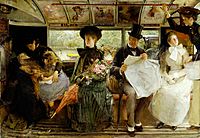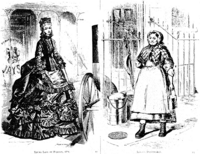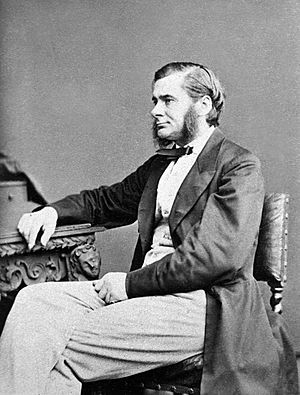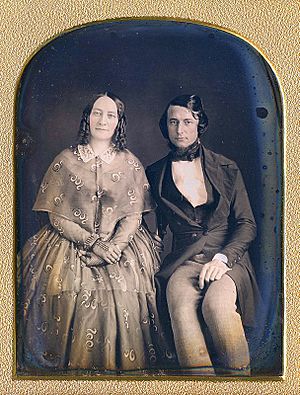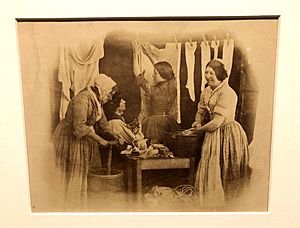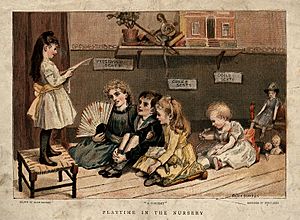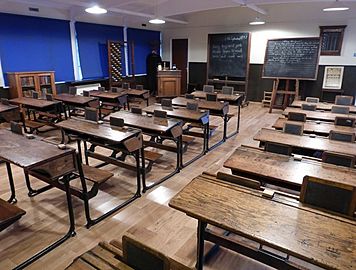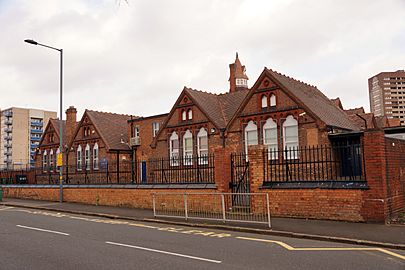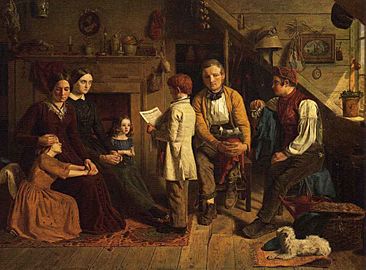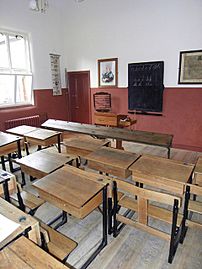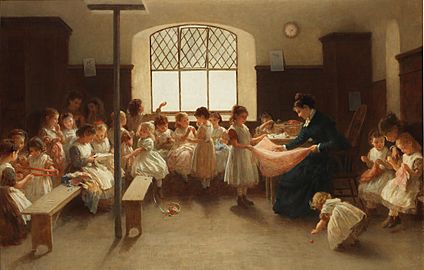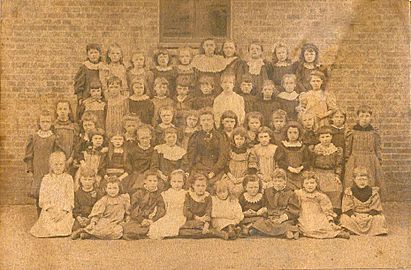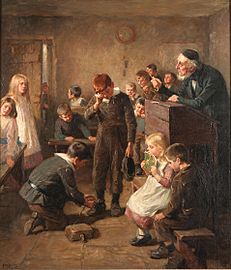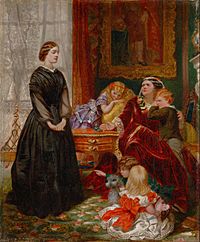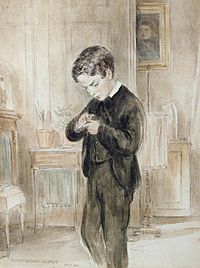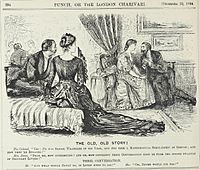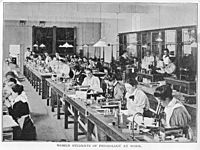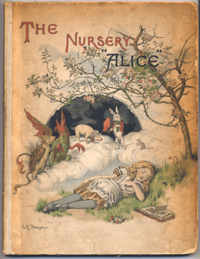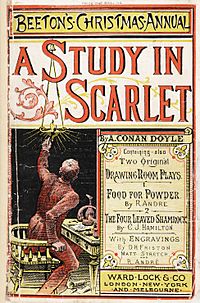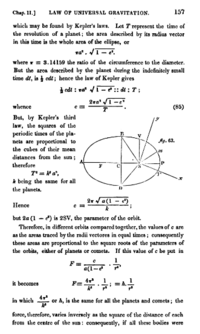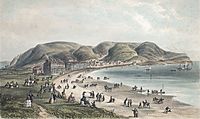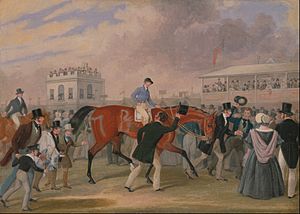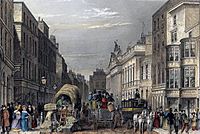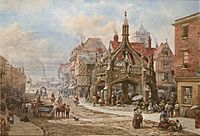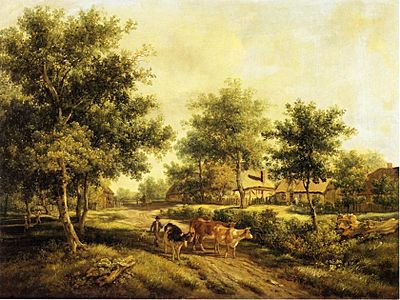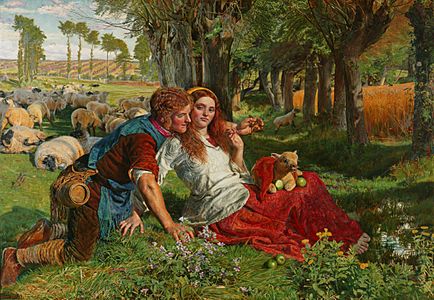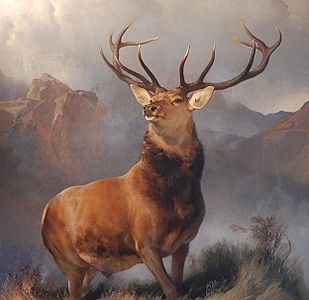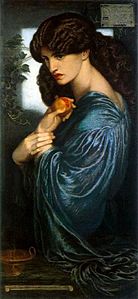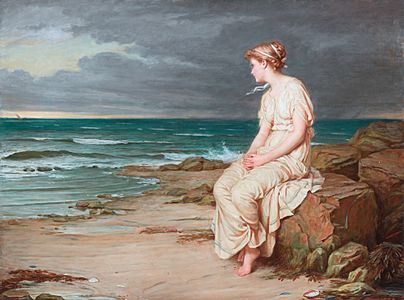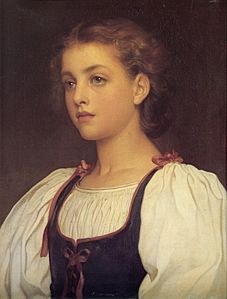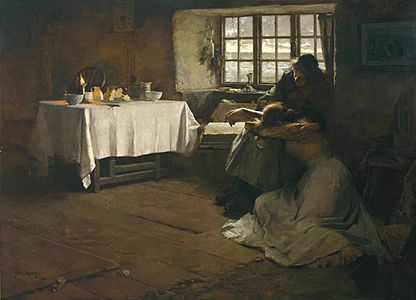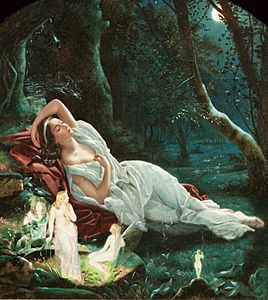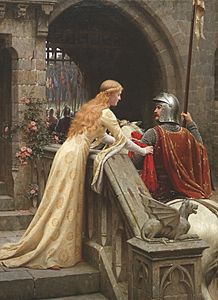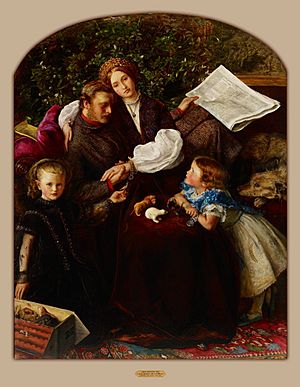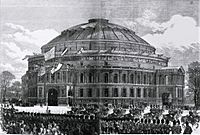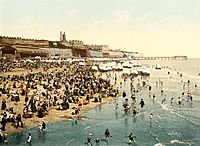Society and culture of the Victorian era facts for kids
The Victorian era, named after Queen Victoria who ruled the United Kingdom from 1837 to 1901, was a time of big changes. During this period, a new group of people, the middle class, grew very quickly. They started to have a huge impact on society and culture, becoming almost as important as the traditional aristocracy.
This growing middle class brought new ideas about how people should live. They valued family life and having a private home. Women were mostly expected to focus on their homes and families, while men were seen as the main providers. For the first time, children gained legal protections against harm and neglect. Strong religious beliefs, especially from the evangelical movement, encouraged people to be respectable and moral. There was also a strong push for social improvements and reforms.
People's access to education greatly improved during the 1800s. The government started funding schools, and going to school became a must for younger children in England, Scotland, and Wales. Because of this, almost everyone could read and write by the end of the century. People also enjoyed many new forms of entertainment, like brass bands, circuses, and seaside holidays. Many popular sports we know today, like cricket and cycling, also became popular during this time. People had more free time as working hours became shorter and annual holidays became more common.
Contents
Everyday Life
The rise of the middle class really shaped the Victorian era. As they gained more power and money, their way of thinking became very important. Their ideas about how to live, what was valuable, and what was right and wrong became common for everyone.
Before this time, homes and workplaces were often mixed together. But in the Victorian era, family life became more separate and private. The home was seen as a special place just for the family, a quiet escape from the busy outside world. This idea of "privacy" became a key part of middle-class life.
The English home became more private and closed off in the 1850s. The idea of a cozy home matched a new focus on privacy. Middle-class life was all about indoor spaces, with heavy curtains and a cautious approach to outsiders. Homes were only opened by invitation for events like parties or teas. Many writers of the time explored the idea that each person is essentially unknown, and that society helps keep up a front behind which many secrets hide.
Helping Society Improve
The Victorian era was a time when people really wanted to make things better, both for individuals and for society. Three main things helped this happen.
First, the middle class grew quickly and started to take over from the old noble families. They believed in being "respectable." A businessman, for example, had to be trustworthy and avoid risky habits like gambling.
Second, a strong religious movement, especially evangelical Christianity, pushed for moral improvements. This included groups like the Methodists and a part of the Church of England. Important figures like Lord Shaftesbury encouraged values like going to church on Sundays, being responsible, helping others, and being strict at home. They were very good at getting people excited about fighting social problems and bad behavior.
Third, thinkers called utilitarians, like Jeremy Bentham and John Stuart Mill, believed in using science and logic to solve problems. They wanted to find the best solutions for society by studying issues, making laws, putting them into action, checking the results, and reporting on them.
These three groups—the middle class, the evangelicals, and the utilitarians—worked together. They shared a common goal of responsibility and improvement, creating a powerful force for change.
Many social reforms happened, such as working to end slavery and improving conditions for women and children. The police force was also reformed to focus more on preventing crime rather than just giving harsh punishments. Important political changes also took place, like giving more rights to people who were not part of the Church of England and reforming Parliament to make it more democratic.
Religion in Victorian Times
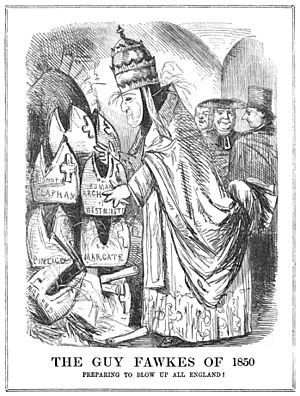
Religion was a big topic of debate. Groups known as Nonconformists, who were not part of the official Church of England, fought hard for equal rights, especially in education and public jobs. Laws that discriminated against Catholics were mostly removed. The number of Catholics grew, partly due to people converting and partly due to immigration from Ireland.
At the same time, some educated people started to question traditional religious beliefs, especially as science advanced quickly. They wondered if parts of the Old Testament were accurate. This period is sometimes called a "Victorian Crisis of Faith," as people tried to make their religious views fit with new scientific discoveries and new ways of looking at the Bible.
Nonconformist Churches
The "Nonconformist conscience" refers to the strong moral beliefs of the Nonconformist churches. These churches, which were separate from the Church of England, had a big impact on British politics. In 1851, about half of the people attending Sunday church services were Nonconformists. They were often found among the growing middle class in cities.
There were two main types of Nonconformists: the "Old Dissenters" (like Baptists and Quakers) who focused on religious freedom and equality, and the "New Dissenters" (mainly Methodists) who stressed personal morality, such as avoiding alcohol and keeping Sundays special. Both groups were active in politics, and over time, they mostly joined forces with the Liberal party. They worked together on issues like schools and temperance (avoiding alcohol).
For a long time, Nonconformists faced legal disadvantages. They couldn't hold many public jobs, had to pay taxes to the Anglican church, and couldn't get degrees from Oxford or Cambridge universities. They fought hard to remove these unfair laws. In 1828, some restrictions were lifted, which was a big win. They continued to push for more changes. For example, in 1868, they no longer had to pay taxes to support the Anglican church. Laws were also changed to allow civil marriages and for Nonconformist ministers to marry couples in their own chapels. By 1871, Nonconformists finally gained full access to degrees and jobs at Oxford and Cambridge. They also played a big role in starting new universities in cities like Manchester and Birmingham.
Agnostics and Freethinkers
The idea of agnosticism became popular around 1869, when T. H. Huxley created the term. Agnosticism means believing it's impossible to know if God exists. This idea was discussed for many years. People who didn't believe in God often called themselves "freethinkers" or "secularists." These included famous writers like John Stuart Mill and George Eliot. They often argued that you didn't need to believe in God to be a good and moral person.
Scientists, on the other hand, were more interested in the new ideas from Charles Darwin about evolution. The old idea that God must exist because the world was so complex didn't seem as strong when biology showed how complexity could develop through evolution.
Because of these scientific discoveries, and the rise of freethinkers, historians talk about a "Victorian Crisis of Faith." This was a time when people had to adjust their beliefs and ideas about morality as religious views changed.
Marriage and Family Life
Family was extremely important to Victorians of all social classes. People worried about anything that seemed to threaten family life, like wives working outside the home or bad living conditions. The home became a safe place away from the harsh outside world. Middle-class wives often took care of all household matters so their husbands didn't have to. Families also started having fewer children, which meant each child could get more attention. The "nuclear family" (parents and their children) became the ideal and most common family type.
During this time, the idea that marriage should be based on romantic love and companionship, rather than just money or convenience, became more popular. Cheaper paper and printing made it easier for people to express their feelings, leading to the rise of Valentine cards.
Women's Roles
For middle-class women, the common idea was "separate spheres." This meant women were expected to stay out of public life, like politics, paid work, and business. Instead, their main role was in the home, taking care of the family, husband, children, and household. They were also seen as responsible for religious and moral behavior. Nonconformist churches gave women new ways to be involved, like teaching in Sunday schools, visiting the sick, and helping with fundraising.
A famous poem from 1854, The Angel in the House, described the ideal Victorian woman as pure and completely dedicated to her family and home. This poem reflected the legal, social, and moral values of the middle class. Legally, women had very limited rights to family property or their children. Their main identities were as a daughter, wife, mother, or widow. As society became more prosperous, fewer women needed to work for money. The home became a bigger focus, with women making decisions about furniture, clothing, food, and their children's schooling.
However, some early feminists started to call for women to have more opportunities outside the home. By the end of the century, a "New Woman" emerged, who might ride a bicycle, wear different clothes, sign petitions, and talk about women getting the right to vote.
Children's Lives
For much of the 1800s, parents and guardians had almost complete power over children. The right of parents to raise their children as they wished, and to use corporal punishment to make them obey, was seen as more important than concerns about children's safety.
However, attitudes began to change in the 1880s. Groups focused on child welfare started forming across the country, leading to the creation of the National Society for the Prevention of Cruelty to Children. In 1889, the Children's Charter became law. This was the first time the government could step in to protect children from mistreatment by their parents. Children's rights were further expanded five years later.
Learning and Reading
The Industrial Revolution made people think more scientifically and want to be more educated. Formal education became very important.
At the start of the 1800s, not everyone agreed that educating working-class children was a good idea. Some thought it was unnecessary or even risky. But by the 1830s, most people believed that the benefits of education outweighed the risks of leaving children uneducated.
Many children went to Sunday schools, which taught them to read, and sometimes writing and math. The number of children attending Sunday schools grew a lot. Religious groups also started "voluntary" full-time schools, and private schools became more common. However, in the 1850s, about half of children in England and Wales were not in school during the week, and those who did attend usually only went for about three years.
In England and Wales, the government started funding schools before Queen Victoria's reign, and this funding increased. The 1870 Elementary Education Act aimed to provide state-funded schools for everyone. The government also started running schools directly. Education became mandatory for five- to ten-year-olds in 1880, and school fees were removed in 1891. Compulsory education was later extended to deaf and blind children, and to children up to age twelve. Scotland had a longer history of state-funded education, and similar reforms happened there in the late 1800s.
As a result of these changes, more and more people learned to read and write. By the late 1800s, about 90% of people in England and Wales could sign their names on marriage registers, which shows how common literacy had become. This rise in literacy, along with more people living in cities, created a huge demand for books, magazines, and other printed materials.
Education for Wealthier Children
For wealthier families, formal schooling became normal for boys in the first half of the 1800s. It was seen as essential for future businessmen and professionals. Many boys went to private schools or expensive "public schools" like Eton, which became models for gentlemen and public service. Many of these boys later held important government jobs.
Most girls from wealthier families were taught by governesses at home or went to private schools. These girls' schools gradually became more academic. New schools like the North London Collegiate School and Cheltenham Ladies' College were founded in the 1850s. By the end of the century, some girls' schools even prepared students for university.
At universities like Cambridge, students took very challenging exams, especially in mathematics. These exams were important for future civil servants, lawyers, and religious leaders. Science education also improved at Oxford and Cambridge in the 1850s.
The first colleges for women opened in the 1870s, like Girton at Cambridge University. However, women were only allowed to take exams; they couldn't receive degrees until 1948. Their results were often compared to men's. It was a big surprise when Philippa Fawcett scored higher than the top male student in the math exam in 1890.
While women were not easily accepted into medicine, nursing became a highly respected profession, especially after Florence Nightingale's work during the Crimean War. Her nursing school became a model for others, making nursing an appealing career for many middle-class young women.
Reading for Everyone
The publishing world changed a lot during the 1800s, thanks to new technologies like electricity, trains, and the telegraph. More and more people wanted to read for knowledge, self-improvement, and fun, especially the growing middle class.
At first, books were expensive. But as free libraries opened, more people started reading. Authors and publishers looked for ways to make books cheaper and sell more. Stories often appeared in parts in magazines before being published as full books. Many writers became professional novelists.
Children's books, which used to be mostly religious with strong moral messages, started to change. By the mid-1800s, publishers saw the potential in this market. They hired talented authors and used new printing methods to add colored pictures. As the middle class grew, parents had more money to spend on entertaining their children. Fun became more important than just moral lessons. Classic fairy tales and new stories like Alice's Adventures in Wonderland (1865) became very popular. By the 1880s, adventure stories for kids were common. Many famous writers of the time wrote at least one children's book. Children's magazines and silly poems also became popular.
Novels became the most important type of literature by the end of the era. Some novels, called "social novels," explored the problems caused by industrialization. Later, mystery stories and science fiction also became very popular. Robert Louis Stevenson's Strange Case of Dr Jekyll and Mr Hyde (1886) and Oscar Wilde's The Picture of Dorian Gray (1891) are famous examples.
The works of William Shakespeare became incredibly popular in the 1800s. Charles and Mary Lamb wrote Tales from Shakespeare (1807), which simplified Shakespeare's plays for younger readers. This book became a bestseller.
There was also a growing demand for popular science books. Mary Somerville was a very successful science writer. Her book On the Connexion of the Physical Sciences (1834) explained science to a wide audience and was very popular. It gave readers a broad overview of different sciences.
Newspapers became cheaper and more common after taxes on them were removed in the 1850s. This led to more magazines covering many different interests. Women's newspapers and magazines also grew, covering more than just home topics.
The development of a professional police force inspired writers like Charles Dickens to create detective stories. But Arthur Conan Doyle's Sherlock Holmes became the most famous fictional detective of the Victorian age.
By the 1860s, people wanted adventure, detective, and science fiction novels. The many technological advances of the late 1800s inspired authors like H. G. Wells, whose The Time Machine (1895) introduced the idea of time travel. Sometimes, science fiction even inspired new technology and scientific research.
Before newspapers were widely available, people got information and entertainment from public notices, handbills, and cheap printed sheets called broadsheets and ballads. These covered local news, advertisements, and stories about crimes or disasters. Small, cheap books called Chapbooks were also common, read by both poor adults and middle-class children.
Fun and Games
Victorian people enjoyed many forms of entertainment, which varied by social class. They loved literature, theatre, art, and music. Operas and plays were very popular. The comic operas by Gilbert and Sullivan were especially famous.
Wealthier men often went to dining clubs. Brass bands and 'The Bandstand' became popular. You could often hear a brass band playing in parks.
The Victorian era was the "golden age" for British circuses. Astley's Amphitheatre in London was a famous circus with horse acts. Traveling circuses, like Pablo Fanque's, were popular across Britain. Pablo Fanque was a black man who achieved great success and was admired by the public, which was remarkable so soon after Britain had abolished slavery.
Another type of entertainment involved "spectacles" where people performed what seemed like paranormal events, such as mesmerism or talking to the dead. These activities were very popular.
Many people enjoyed nature as a hobby. They collected birds, butterflies, seashells, beetles, and wildflowers. These amateur collectors helped build large natural history collections.
Middle-class Victorians started taking train trips to the seaside, especially after the Bank Holiday Act of 1871 created more public holidays. Quiet fishing villages like Worthing and Scarborough became popular tourist spots. People like Thomas Cook saw tourism as a good business.
Sports
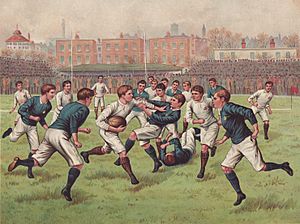
Many modern sports began or became popular in the Victorian era. Often starting in public schools, they helped define new ideas of manliness. Cricket, cycling, croquet, horse-riding, and water sports were all popular.
The modern game of tennis started in Birmingham, England, between 1859 and 1865. The oldest tennis tournament in the world, the Wimbledon championships, was first played in London in 1877. Britain also competed in the Olympic Games starting in 1896.
Opportunities for leisure activities grew a lot as people earned more money and worked fewer hours. The nine-hour workday became common in cities, and the Factory Act of 1874 limited the work week to 56.5 hours. Annual holidays also became more common.
By the late Victorian era, the entertainment industry was booming in all cities. It offered scheduled shows at convenient places for low prices. These included sports events, music halls, and popular theatre. Football, for example, became very popular with working-class audiences. By 1900, professional sports were a big business. Some new activities, like lawn tennis and golf, became popular among wealthier amateurs. Women were also allowed to participate in some sports, like archery and gymnastics.
Art and Architecture
Gothic Revival architecture, which copied medieval styles, became very important. This led to a "Battle of the Styles" between Gothic and Classical designs. For example, the new Palace of Westminster (where Parliament meets), which was damaged in a fire, was rebuilt in a medieval style. This showed a connection to the past, unlike the big changes happening in France.
The middle of the 1800s saw The Great Exhibition of 1851, the first World's Fair. It showed off the century's greatest inventions. At its center was the Crystal Palace, a huge building made of glass and iron. This was a new type of building. The invention of photography, also shown at the Great Exhibition, changed Victorian art. Queen Victoria was the first British monarch to be photographed.
Many painting styles were popular, including Classicism and Romanticism. In 1848, Dante Rossetti and William Holman Hunt formed the Pre-Raphaelite Brotherhood. They wanted to create paintings that looked almost like photographs, taking ideas from Shakespeare and nature. The growing popularity of romantic love also influenced art and literature.
Famous Victorian Paintings
-
The Hireling Shepherd (1851) by William Holman Hunt.
-
Monarch of the Glen (1851) by Edwin Landseer.
-
Proserpine (1874) by Dante Rossetti.
-
Miranda (1875) by John William Waterhouse.
-
Biondina (1879) by Frederick Leighton.
-
God Speed! (1900) by Edmund Leighton.
Newspapers and News
In 1817, Thomas Barnes became the editor of The Times newspaper. He was a strong supporter of press freedom. Under Barnes and later John Thadeus Delane, The Times became very influential. It started the practice of sending war correspondents to cover conflicts. W. H. Russell wrote powerful reports from the Crimean War (1853–1856), showing the public the harsh reality of war. His reports about poor medical care led to major reforms, especially in nursing, thanks to Florence Nightingale.
The Manchester Guardian was started in Manchester in 1821 by Nonconformist businessmen. Its editor, Charles Prestwich Scott, made it a world-famous newspaper in the 1890s. The Daily Telegraph became London's first "penny newspaper" in 1856, meaning it was very cheap because it made money from advertising.
Free Time
In the mid-1800s, people wanted a large building for music and talks. Prince Albert supported this idea. After his death, the Royal Albert Hall was built to honor him, opening in 1871. It was designed to hold thousands of people and was funded privately.
Opportunities for leisure activities grew a lot as people earned more and worked less. In cities, a nine-hour workday became common, and a law in 1874 limited the work week to 56.5 hours. Annual holidays also became more regular. About 200 seaside resorts developed thanks to cheap hotels, affordable train fares, and new public holidays.
By the late Victorian era, the entertainment industry was big in all cities. It offered planned entertainment at convenient places and low prices. This included sports events, music halls, and popular theatre. Football, for example, became very popular with working-class audiences. By 1900, professional sports were a huge part of the economy. Some new activities, like lawn tennis and golf, became popular among wealthier amateurs. Women were also allowed to participate in some sports, like archery and gymnastics.
Images for kids
-
Edinburgh Ale, 1844 by David Octavius Hill and Robert Adamson.


